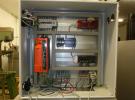Hello,
I am trying to use PulseOut and DigitalIO commands with LabJackPython. I am getting the Errorcode 40 (Illegal Input).
Unfortunately, I didn't find any useful examples for this command. Could you please post some Python example to make a pulse of 50Hz?
Thanks in advance!



.png%3Fitok=PHGBxf6M)


.jpg%3Fitok=B1YcuDFK)
.png%3Fitok=Ybt-OlgU)
Someone else can follow up specifically about Python, but here is the driver code that throws that error:
//Make sure each input is within the proper range
if ((bitSelect<0) || (bitSelect>255))
{
errorcode=ILLEGAL_INPUT_ERROR_LJ;
*idnum=-1;
return errorcode;
}
if ((numPulses<1) || (numPulses>32767))
{
errorcode=ILLEGAL_INPUT_ERROR_LJ;
*idnum=-1;
return errorcode;
}
if ((timeB1<1) || (timeB1>255))
{
errorcode=ILLEGAL_INPUT_ERROR_LJ;
*idnum=-1;
return errorcode;
}
if ((timeC1<1) || (timeC1>255))
{
errorcode=ILLEGAL_INPUT_ERROR_LJ;
*idnum=-1;
return errorcode;
}
if ((timeB2<1) || (timeB2>255))
{
errorcode=ILLEGAL_INPUT_ERROR_LJ;
*idnum=-1;
return errorcode;
}
if ((timeC2<1) || (timeC2>255))
{
errorcode=ILLEGAL_INPUT_ERROR_LJ;
*idnum=-1;
return errorcode;
}
Likely you are passing a parameter value that is invalid. General documentation on these functions can be found here:
https://labjack.com/support/datasheets/u12/programming-reference/digitalio
https://labjack.com/support/datasheets/u12/programming-reference/pulseou...
https://labjack.com/support/datasheets/u12/programming-reference/pulseout
For Python doc., use the help function on digitalIO, pulseOutCalc and pulseOut U12 class methods.
A quick example:
import u12
dev = u12.U12()
# Set D0 and D1 to output-low, the rest as inputs. Lines for pulses need to be
# outputs.
dev.digitalIO(idNum=-1, demo=0, trisD=3, trisIO=0, stateD=0, stateIO=0,
updateDigital=1)
# Get B and C values for 50 Hz frequency.
dev.pulseOutCalc(frequency=50)
timeB = res['timeB']
timeC = res['timeC']
# Pulse D0 and D1 500 times, 50 Hz frequency
dev.pulseOut(bitSelect=3, numPulses=500, timeB1=timeB, timeC1=timeC,
timeB2=timeB, timeC2=timeC, idNum=-1, demo=0, lowFirst=0)
Thanks for quick answer!
I tried the code but I believe I am still missing the point here.
D0 and D1 stands for AI0 and AI1? What does this trisD parameter really? How to use bitSelect?
I've measured the output on A01 with a scope and the result is in the attachment.
Thank you!
The D lines are digital I/O available through the DB25 connector, and do not stand for AI lines which are analog inputs and can't perform pulses:
https://labjack.com/support/datasheets/u12/hardware-description/d0-d15
TrisD and bitSelect are documented like so:
TrisD - Directions for D0-D15. 0=Input, 1=Output
bitSelect - Set bits 0 to 7 to enable pulsing on each of D0-D7 (0-255).
With these kind of settings, each bit represents an I/O setting, where bit 0 is a D0 setting, bit 1 is a D1 setting, bit 2 is a D2 setting, etc..
With TrisD, which sets D0-D15 line directions, say you want D0 and D2 as digital outputs, and the rest of the lines as inputs. In binary that looks like b0000000000000101, which is decimal value 5 (20 + 22) that you pass for TrisD.
With bitSelect, which sets what D0-D7 lines to pulse on, setting a line's bit to 1 enables pulsing and 0 is don't pulse. So similar to TrisD, if you want to send the pulses through D0 and D2 only, in binary that is b00000101, decimal value 5.